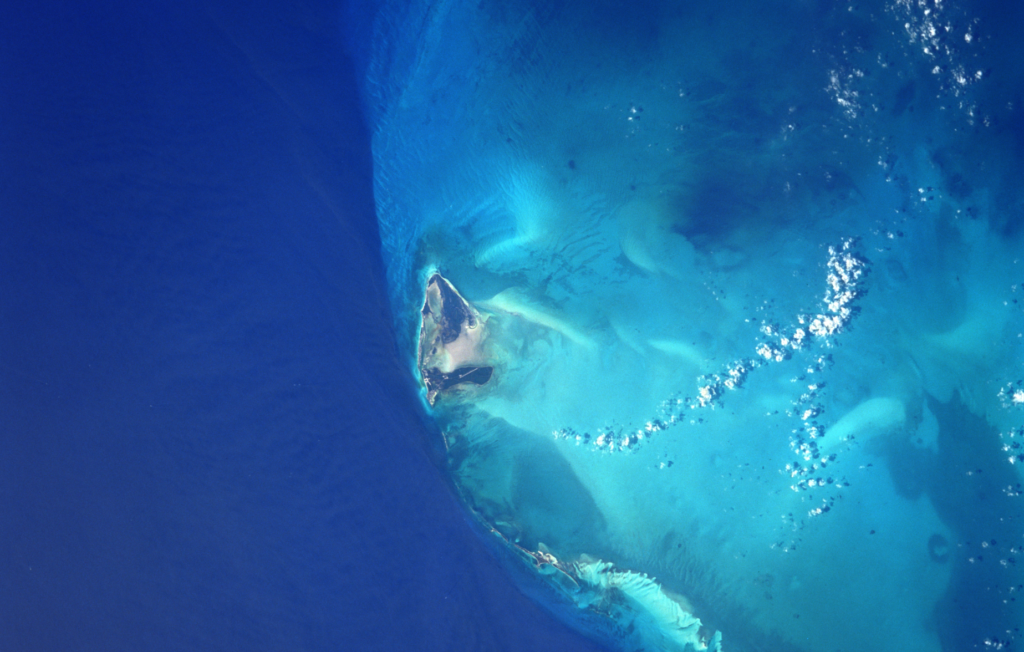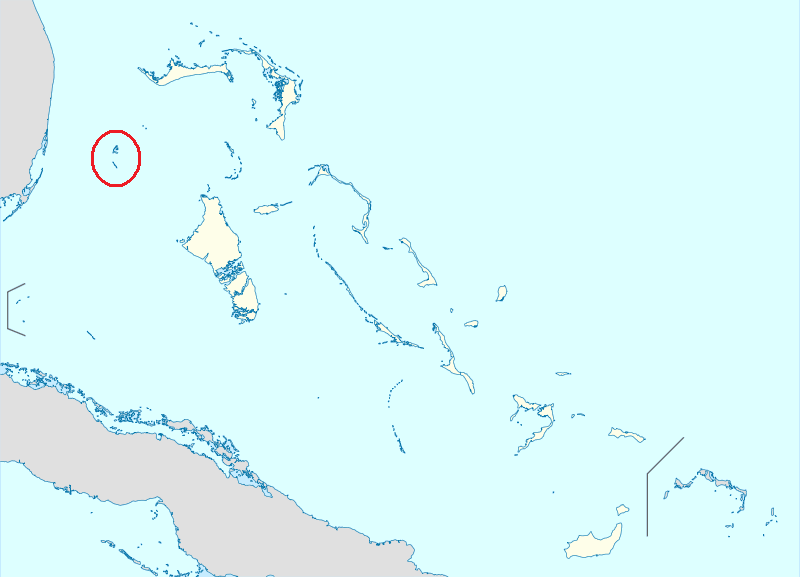In the depths of the crystalline Bahamian waters lies a mystery that has captivated the imagination of researchers, adventurers, and dreamers alike. This is the enigmatic Bimini Road.
It stretches across the ocean floor off the coast of North Bimini Island. This perplexing underwater rock formation has for decades sparked intense debate over its origins.
Geologists argue about its natural origins as a geological beach rock formation. But there also exists an alluring undercurrent of speculation regarding its formation.
Could the Bimini Road be the forgotten road leading to a long-lost civilization? Might it be a link to the fabled city of Atlantis, long submerged by the sea?
Uncovering the truth behind the possible connection between Bimini Road and the enigmatic Atlantis requires us to dig deeper into its history, geology, and modern-day theories of its nature. Only then, can we know for sure.

Bimini Island, one of the Bahama Islands, from space, June 1998
A Discovery off North Bimini Island
In 1968, off the northwest coast of North Bimini Island in the Bahamas, a group of divers made a discovery that would send ripples of excitement through the world.
While exploring the seafloor, a series of stones caught their attention. They were lying about 18 feet beneath the surface. What intrigued the divers was the striking resemblance of these stones to man-made structures. They were arranged in an evenly spaced line stretching over half a mile.
The finding was nothing short of remarkable. The media swiftly latched onto the story.
Speculations ran wild. Numerous individuals asserted that these stones could be part of an ancient wall or a road once belonging to a lost civilization. Possibly even connected to the fabled Atlantis.
The excitement intensified when two other similar “roads” were discovered nearby. This further fueled the mystery surrounding the site.
Joseph Manson Valentine, Jacques Mayol, and Robert Angove were the pioneers who encountered this intriguing phenomenon in the tranquil waters. They described it as a “pavement” composed of rounded stones of various sizes and thicknesses.
This feature, now known either as the “Bimini Road” or “Bimini Wall,” stretches in a northeast-southwest direction. It is accompanied by two parallel linear features closer to the shore.
The discovery of the Bimini Road set the stage for plenty of scientific exploration and investigation. But there is also controversy. Experts and speculators alike sought to determine the truth behind this fascinating structure.
Geology and Composition
Since its discovery, the geological composition of the Bimini Road rocks has been a subject of scientific investigation and heated debate.
The formation consists of a total of three straight formations under the waves. These features are mostly made up of enormous, flat, rectangular limestone blocks.
The largest feature is a northeast-southwest linear feature that extends about half a mile. It has a pronounced hook at its southwest end.
It’s made of sizable stone blocks. The dimensions reach 12 feet across, and average about 6-9 feet. Larger blocks fit together remarkably well, while many of the smaller ones lack this feature.
In contrast, the two narrower and shorter linear features, lying closer to the shore, consist of smaller stone blocks measuring just a few feet across. These blocks have more rounded corners.
Geologically, Bimini Road consists primarily of limestone. Specifically, a type of well-cemented sedimentary rock known as “beach rock” which is native to the Bahamas.
It’s worth noting that today the blocks appear highly eroded. Any original surface features, such as tool marks, inscriptions, or other evidence of human involvement, would likely not have survived.
With all this in mind, we must jump to what is the most often-asked question: is Bimini Road simply a miraculous natural formation? Or does it conceal a different story altogether?
Could the Bimini Road Be Connected to the Lost City of Atlantis?
The intriguing connection between Bimini Road and the mythical city of Atlantis can be traced back to the 1930s. This is when an American psychic named Edgar Cayce claimed to have communicated with an individual who had lived in Atlantis in a previous life.
According to Cayce’s revelations, Atlantis was located near Bimini. He prophesied that portions of the city’s temples would emerge near the island around 1968 or 1969.
The prediction stirred curiosity. And when divers reported seeing the peculiar parallel structure of Bimini Road in shallow waters, speculation soared.
Many believed that these formations were either remnants of the walls of Atlantis or an enigmatic road leading to the lost city. This gave birth to the mysterious legend of the Atlantis Road.
Most scientific researchers contend that Bimini Road is a naturally occurring geological formation. But others find that hard to believe. Instead, they see the remains of an ancient road, wall, or other deliberately constructed structure.
To that end, articles published in Argosy, an American pulp magazine, first suggested in 1971 that the massive stone blocks found at Bimini Road had been cut by humans.
The debate surrounding the site’s connection to Atlantis continues to this day, with some prominent figures, such as Graham Hancock and Charles Berlitz, supporting the idea. Bimini Road even features in Hancock’s recent hit Netflix special, Ancient Apocalypse.
Nevertheless, most mainstream geologists and archaeologists maintain that it is likely a natural formation.

Map of the Bahamas with Bimini Island circled
The Lasting Allure of the Bimini Road
Despite the allure of the Atlantis legend, the true nature of the underwater road remains fraught with disagreement. It still invites further exploration from adventurers and historians alike.
In recent years, detailed studies have replicated the sequence of natural, geological events that could be responsible for creating such an underwater rock formation. Other similar formations have been documented elsewhere, such as Australia and Florida.
Despite the scientific analysis pointing towards Bimini Road being a natural geological feature, the legend of Atlantis continues to infuse an air of mystery and fascination around the site. The alluring prospect of an ancient civilization, lost beneath the waves, captivates our imaginations and beckons the adventurous spirit.
Whether a geological oddity or the lost remnants of Atlantis, Bimini Road is a testament to the mysteries that lie beneath the ocean’s surface. It will certainly remain an intriguing site for years to come.
As we embrace the evidence, we can also cherish the thrill of exploration and speculation. It is in this dance between fact and mystery that the true magic of Bimini Road resides.
References
Andersson, Pia. “Alternative Archaeology: Many Pasts in Our Present.” Numen 59, no. 2/3 (2012): 125–37. http://www.jstor.org/stable/23244955.
“Bimini Road/The Lost City of Atlantis.” Bimini Road – The Official Website of the Bahamas, 2023. https://www.bahamas.com/natural-wonders/bimini-road.
“Bimini Road/The Lost City of Atlantis.” The Islands of the Bahamas, 2023. https://bahamasgeotourism.com/entries/bimini-road-the-lost-city-of-atlantis/be71653a-b8c9-4bf3-8165-173e1e8bed0d.
Black, Annetta. “Bimini Road.” Atlas Obscura, July 19, 2016. https://www.atlasobscura.com/places/bimini-road.

